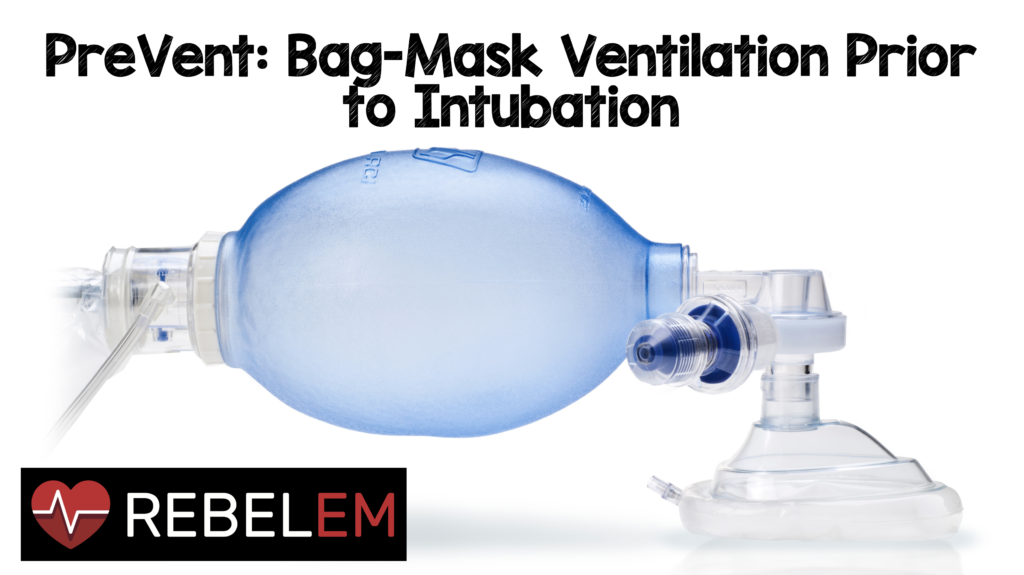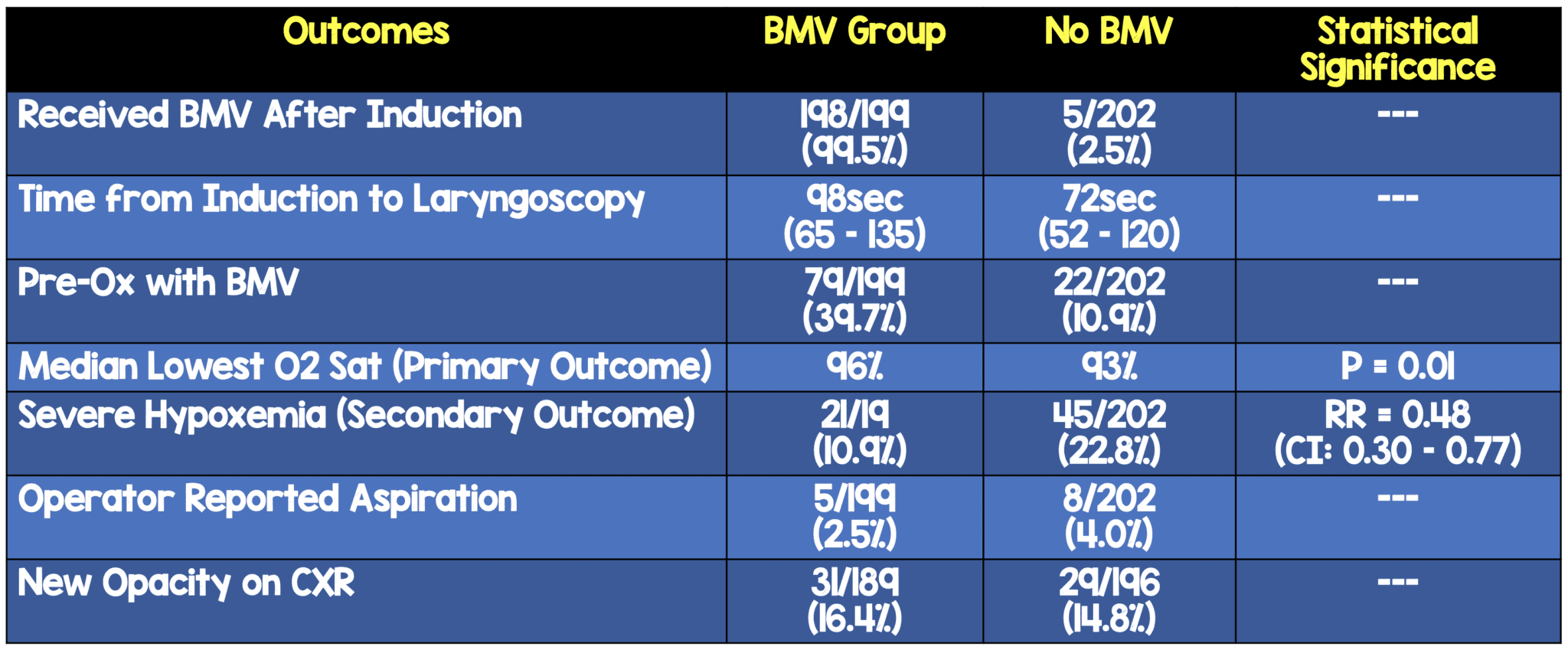
 Background: Rapid Sequence Intubation (RSI) is a common procedure performed by both emergency clinicians and intensivists. Although the procedure is complex, the major pieces are pre-oxygenation, administration of a sedative agent in close proximity with a paralytic, laryngoscopy and placement of an endotracheal tube without the provision of any ventilations during the process. The avoidance of bag-mask ventilations (BMV), or any positive pressure breaths, rests on the belief that those breaths can distend the stomach and lead to regurgitation and aspiration. For this to happen, the force of the breath must exceed the pressure of the lower esophageal sphincter (~ 20 mm Hg). Critically ill patients presenting with airway compromise cannot be guaranteed to have a fasting state, regurgitation and aspiration is a major concern.
Background: Rapid Sequence Intubation (RSI) is a common procedure performed by both emergency clinicians and intensivists. Although the procedure is complex, the major pieces are pre-oxygenation, administration of a sedative agent in close proximity with a paralytic, laryngoscopy and placement of an endotracheal tube without the provision of any ventilations during the process. The avoidance of bag-mask ventilations (BMV), or any positive pressure breaths, rests on the belief that those breaths can distend the stomach and lead to regurgitation and aspiration. For this to happen, the force of the breath must exceed the pressure of the lower esophageal sphincter (~ 20 mm Hg). Critically ill patients presenting with airway compromise cannot be guaranteed to have a fasting state, regurgitation and aspiration is a major concern.
However, there’s another side to this. Many of our patients who are critically ill have intrapulmonary shunting; portions of the lung are atelectatic, filled with fluid, blood, or pus and not being oxygenated though they are being perfused. Blood running through these portions of the lung will be deoxygenated and will lower the overall O2 content of blood entering the systemic circulation after mixing with blood coming from ventilated regions. This shunting at least partially explains why we see patients rapidly desaturating during intubation. Positive pressure can recruit atelectatic portions of the lung that are not involved in gas exchange thus decreasing the physiologic shunt and increasing the patient’s oxygen reserve.
Despite decades of experience with RSI we continue to look for better approaches since the procedure still poses serious risks to the patient. Recent modifications that have seen wide adoption include using the bed-up-head-elevated (BUHE) position, suction assisted laryngoscopy for airway decontamination (SALAD) and bougie first intubation, though there are many more. Now, a publication in the NEJM makes us question the core principle of BMV during RSI.
Article: Casey JD et al. Bag-Mask Ventilation During Tracheal Intubation of Critically Ill Adults. NEJM 2019. PMID: 30779528
Clinical Question: Does the addition of BMV after induction prior to tracheal intubation lead to an improvement in the lowest oxygen saturation?
Population: Patients > 18 years of age undergoing tracheal intubation in one of seven academic ICUs in the US.
Outcomes:
-
- Primary: Lowest O2 saturation observed during the interval between induction and 2 minutes after tracheal intubation
- Secondary: Incidence of severe hypoxemia (< 80%)
Intervention: Bag-mask ventilation (BMV) provided by clinicians during the interval from induction to initiation of laryngoscopy
-
- BMV – oxygen flow rates of at least 15 liters/minute
-
- PEEP valve set to 5-10 cm of water
-
- Oropharyngeal airway in place
-
- Two-handed mask seal performed by the intubating clinician with a head-tilt and chin-lift maneuver
-
- Ventilation at 10 breaths/minute
- Smallest tidal volume to generate chest rise.
Control: No BMV between induction and laryngoscopy (unless there was a failed laryngoscopy attempt or as treatment for hypoxemia or if the clinician decided that BMV was necessary for patient safety)
All methods of pre-oxygenation including bag-mask ventilation and non-invasive ventilation could be used in either group prior to induction.
Apneic oxygenation was allowed but not mandated in both groups
Design: Multicenter, parallel-group, unblinded randomized trial
Excluded: Pregnancy, incarceration, immediate need for intubation prior to randomization or if the treating clinician determined that ventilation between induction and laryngoscopy was either required (treatment of hypoxia or severe acidemia) or contraindicated (increased risk of aspiration from ongoing emesis, hematemesis or hemoptysis)
Primary Results:
-
-
- 667 patients were screened, and 401 patients were enrolled
-
- Median age: 60 years
-
- ~ 50% of patients had sepsis or septic shock
- ~ 60% of patients had hypoxemia respiratory failure as the indication for intubation
-
Critical Findings:
- Mean difference in lowest O2 sat (after adjustment): 4.7% (95% CI 2.5 – 6.8)

Strengths:
-
- Well-designed study that asks a clinically important question
-
- Randomization approach was robust
-
- Funding entity had no role in the conception, design, or conduct of the trial, nor did they participate in the collection, management, analysis, interpretation, presentation, preparation, review, or approval of the manuscript
-
- Exclusions were minimal making the study more generalizable
-
- Patients in the different groups were well balanced for severity of disease
-
- Noninvasive ventilation during the interval between induction and laryngoscopy was not allowed in either trial group because it could confound the provision of bag-mask ventilation.
- Rates of protocol non-compliance and missing data were low
Limitations:
-
- This was not an ED study but rather one performed in the ICU (Respiratory failure is respiratory failure but, if the patient has been in the ICU for a couple of days and then gets intubated, they are different than a fresh presentation particularly when it comes to fasting)
-
- The primary outcome (lowest O2 sat) is not nearly as important as the secondary outcome (severe hypoxemia)
-
- Patients requiring immediate intubation were not included as they could not be randomized. These results may not apply to this group
-
- Patients, clinicians, and research personnel were aware of trial-group assignments after randomization (blinding was not feasible) This could potentially affect the type of preoxygenation technique a provider would choose to use.
-
-
Not all baseline characteristics were equal between the groups:
-
- The no BMV group had a significantly higher rate of pneumonia (39.6% vs 28.6%) than the BMV group
-
- Hypercarbic respiratory failure was more common in the no BMV group (27.2% vs 19.6%)
- The BMV group had a significantly higher rate of gastrointestinal bleeding (15.6% vs 8.9%) than the no BMV group
-
-
Not all baseline characteristics were equal between the groups:
- A much larger percentage of patients in the BMV group were pre-oxygenated with a BMV (39.7% vs 10.9%) or with any positive pressure (66.3% vs 55%)
Discussion:
-
- The application of BMV was standardized via structured education. This is critically important because application of poor BMV technique (what we currently do much of the time) is virtually guaranteed to lead to more issues of regurgitation and aspiration
-
- Noninvasive ventilation was not allowed in either arm between induction and laryngoscopy. This is important as some clinicians do use NIV to improve or maintain pre-oxygenation while ensuring inspiratory pressures < 20 mm Hg.
-
- Severe hypoxemia (secondary outcome) would have been a more important primary outcome to look at rather than lowest O2 saturation. O2 saturation is a linear measurement but, a sat of 99% is really no better than a sat of 93%. However, a sat of 79% is considerably worse than a sat of 85%.
-
- Pre-oxygenation with a BMV, or some other form of positive pressure, was more common in the group getting BMV after induction. Use of BMV prior to induction may have led to increased lung recruitment before the study intervention and thus, may have biased the outcomes towards the BMV arm.
-
- Apneic oxygenation was also more commonly used in the BMV group (100% vs 77%)
-
- Patients in the no BMV arm were more likely to have etiologies that would have benefited from BMV – increased rate of pneumonia and increased rate of hypercarbic respiratory failure
- Though the rate of visualized aspiration was nearly the same in both groups, this study is not large enough, nor was it designed to assess safety
Authors Conclusions:
“Among critically ill adults undergoing tracheal intubation, patients receiving bagmask ventilation had higher oxygen saturations and a lower incidence of severe hypoxemia than those receiving no ventilation.”
Our Conclusions: The use of BMV after induction resulted in improved oxygen saturation with a lower incidence of severe hypoxemia in comparison to no BMV in the ICU. However, there were some important limitations that may overstate the benefit including underlying pathophysiology, pre-oxygenation and apneic oxygenation approach.
Potential to Impact Current Practice: This study should not result in widespread adoption of BMV after induction of the critically ill patient. However, its use should be considered in patients where clinicians perceive there to be inadequate oxygenation due to shunting and where regurgitation risk isn’t increased. Use of BMV must be properly taught to avoid aggressive, high-volume BMV which will likely insulate the stomach leading to regurgitation.
Bottom Line: Though it is unlikely to be necessary in all cases of intubation of critically ill patients, BMV can be considered on a case by case basis and may be particularly useful in patients who are unable to reach appropriate pre-oxygenation (> 95%) despite non-rebreather and nasal cannula at > 15 L.
Post Co-Authored By:

Nikola Tankosic MD
Critical Care Fellow
Geisinger Medical Center
Danville, PA
For More on This Topic Checkout:
- St. Emlyns: JC – Should we Continue Ventilations During RSI?
- Journal Feed: PreVent RCT – Bag-Mask Ventilation During RSI?
- 5 Minute Airway: PreVent Trial and Interview with Jon Casey
- EMNerd (EMCrit): The Case of the Conspicuous Conclusion
- First10EM: PreVent – BVM During RSI (Casey 2019)
- The Bottom Line: PreVent
- The SGEM #281: EM Docs Got an Ambu Bag – The PreVent Trial
Post Peer Reviewed By: Frank Lodeserto, MD (Twitter: @FrankLodeserto) and Salim R. Rezaie, MD (Twitter: @srrezaie)
The post PreVent: Bag-Mask Ventilation Prior to Intubation appeared first on REBEL EM - Emergency Medicine Blog.
